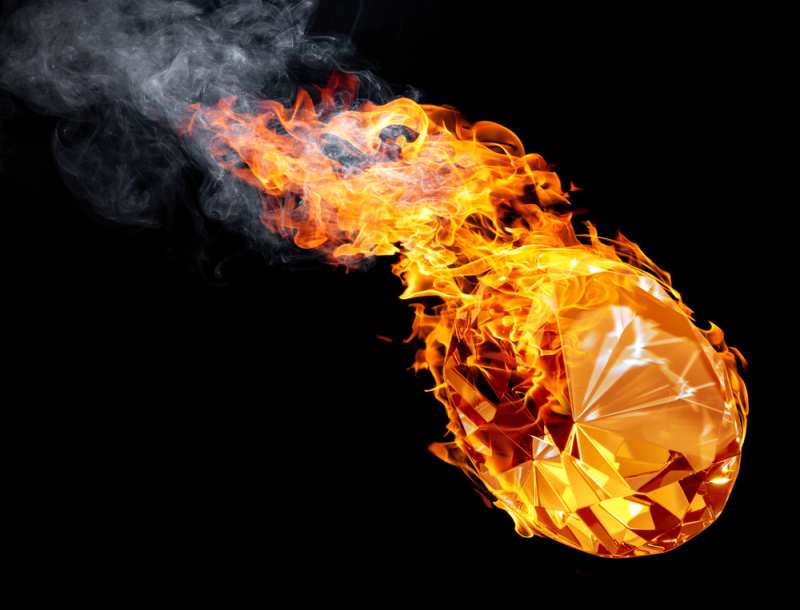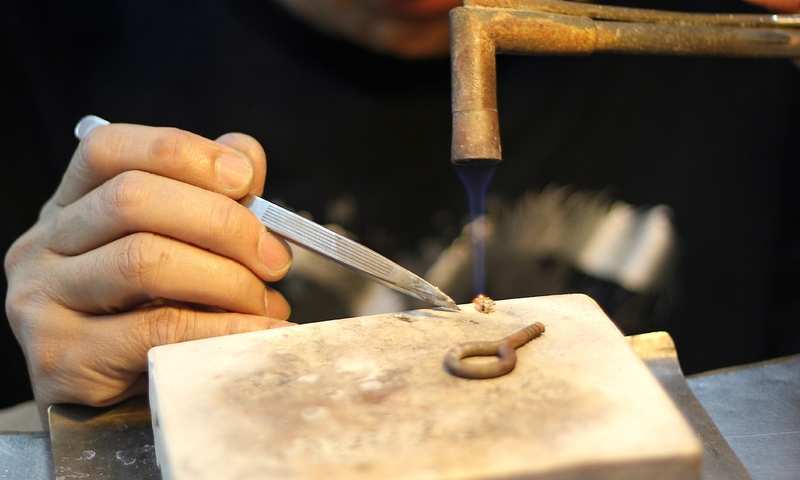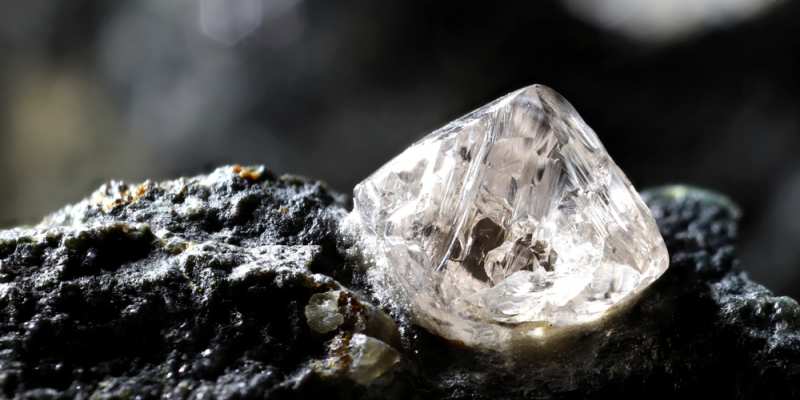We’ve all heard the legendary tales of diamonds being the toughest substance on Earth. They can cut through anything and are seemingly indestructible – you’re familiar with the claims.
However, there’s one aspect that isn’t frequently discussed: fire! Have you ever wondered what would happen if a diamond were subjected to flames? Can diamonds even burn? It’s difficult to envision, we admit. You may picture a flawlessly cut diamond adorning a necklace or displayed in a museum, but what would it look like engulfed in flames?
Curiosity piqued, we embarked on a quest for answers. Through thorough research, we discovered that exposing diamonds to a specific level of heat can result in some intriguing phenomena. But before delving into the effects of heat on diamonds, it’s crucial to comprehend the nature of diamonds themselves.
Shall we proceed and unravel the mysteries surrounding the reaction of diamonds to heat?
DESIGN YOUR OWN ENGAGEMENT RING: START WITH A SETTING OR START WITH A DIAMOND. IT’S REALLY UP TO YOU!

What Will Happen If You Burn A Diamond?
The question at hand is a straightforward one: Can diamonds be burned? In a nutshell, the answer is yes. In fact, anything can be burned if subjected to enough heat. However, when it comes to diamonds, you’ll encounter some challenges in generating the necessary level of heat.
Diamonds are renowned for their toughness, and we aren’t exaggerating in the slightest. They are the hardest material ever discovered on our beautiful planet. As a result, it takes considerable effort to set them ablaze—simply tossing them into a fire won’t suffice.
Why is that the case? To understand how a diamond can catch fire, we must first grasp the principles of combustion. Let’s consider wood, a common fuel source. Igniting a piece of wood usually requires more than just a lighter and patience. We stack newspapers and kindling beneath a log, patiently waiting for the fire to take hold and spread.
So, if we were to toss a diamond into an already lit fire, would it burn like the log? Unfortunately, no. While wood does combust, meaning it catches fire and doesn’t simply melt when exposed to heat, diamonds behave differently.
Fire is essentially a chemical reaction known as combustion. It occurs when certain substances, often gases, react with oxygen in the presence of heat. Wood contains these substances, which are released and react with the oxygen in the atmosphere as the wood heats up.
However, without oxygen, combustion cannot occur. This is why you can’t start a fire in space, regardless of what sci-fi movies might depict.
Now, do diamonds contain the necessary substances for combustion? Do they release these substances when exposed to heat? To answer that, let’s examine what diamonds are actually composed of.
Rest assured, we’ll keep the chemistry lesson brief when it comes to the world’s hardest material. Diamonds are made solely of carbon. Yes, that’s correct—just carbon, without any combination of other famous and resilient elements.
So, what does this mean for our burning question? It means that fire and the combustion process required for it are impossible with diamonds. Without any gases or substances that can be released to interact with oxygen when exposed to heat, fire simply cannot occur.
But that’s alright! After all, we weren’t discussing setting diamonds on fire; we were talking about burning them. Burning a substance can encompass various processes. If you’ve ever held an open flame to plastic, you may have noticed that it doesn’t ignite much fire. However, a reaction does occur—melting.
When subjected to heat, certain materials begin to melt, transitioning from a solid to a liquid state. This process is utilized to shape metals, plastics, glass, and numerous other substances into various forms.
Considering that fire is off the table when it comes to diamonds, why don’t we explore the possibility of melting them instead? Do diamonds have a melting point? And what exactly is a melting point, anyway?

Do Diamonds Melt?
Alright, we’ve established that lighting a diamond on fire is impossible. Regardless of the level of heat applied, diamonds lack the components necessary for combustion. However, if we continue to increase the heat, something else is bound to occur, right?
Indeed, every material possesses a melting point, and exploring the process of melting is the next step in our quest for answers.
Melting, unlike combustion, is a chemical process that marks a phase transition. When exposed to sufficient heat, certain materials shift from a solid state to a liquid state. But why does this transformation take place?
All objects consist of the same fundamental building blocks: atoms, ions, molecules, and so on. To qualify as a specific element, these ions and molecules must be arranged in a particular manner.
In the case of solids, the molecules are tightly packed, resulting in a smaller volume compared to that of a liquid. Moreover, the molecules in a liquid exhibit a higher degree of chaos, lacking a specific structure.
Diamonds exemplify tightly packed molecules, as we mentioned earlier. They are composed solely of carbon atoms. However, it is the arrangement of these carbon atoms that determines the resulting element. Diamonds and graphite, for instance, share the same elemental composition but possess different arrangements.
Consider ice as a perfect example to grasp this concept. Freezing water turns it from a liquid into a solid state. Remove the ice cube from the freezer, and it begins to melt and return to a liquid form. Placing the ice cube on a hot pan accelerates the melting process, eventually leading to evaporation. Similarly, applying pressure to ice produces a similar effect as it affects the arrangement of molecules.
But you may have noticed a discrepancy in this entire process. We’ve all heard about diamonds undergoing incredible heat and pressure during their formation hundreds of miles beneath the Earth’s surface. Do the same principles apply to them?
Yes, but the circumstances differ. Due to their formation in extremely harsh conditions, diamonds require even more extreme conditions to transition between phases. While it is possible, it is far from easy.
The melting point of a diamond is approximately 4000 degrees Celsius (7200 degrees Fahrenheit), at least according to available research. However, this value can be misleading. It represents the melting point under conditions devoid of oxygen—an entirely different atmosphere.
So what about our Earth’s atmosphere? Can diamonds evaporate here? Absolutely!
If we heat a diamond to around 763 degrees Celsius (1405 degrees Fahrenheit), it will begin to evaporate. But wait, isn’t it astonishing that the world’s hardest rock turns into vapor at a mere 700 degrees?
Well, our planet possesses a trick up its sleeve that those stubborn diamonds didn’t consider—oxidation.
Remember how we mentioned that diamonds are tightly packed carbon atoms? It turns out that carbon, when exposed to extreme heat or pressure in the presence of oxygen, undergoes oxidation. The toughest rock in the world ultimately becomes plain carbon dioxide and carbon monoxide.
So, to answer the main question that initiated our exploration—diamonds will vaporize if subjected to sufficiently high temperatures. Can you burn a diamond with a lighter? Absolutely not. However, if you manage to reach temperatures around 800 degrees, the diamond is bound to meet its end.

How We Can Manipulate Carbon?
While it may be challenging to ignite a diamond with an open flame, we have evidence that diamonds undergo phase transitions when subjected to sufficient heat and pressure. So, in a way, we can “burn” them, but what happens when a diamond is burned?
It’s difficult to envision diamonds simply vanishing and vaporizing; it’s not something we’re accustomed to witnessing. However, other phase transitions are possible, although the conditions required for them are exceedingly difficult to achieve.
For instance, by applying the right amount of heat and specific atmospheric pressure, we can cause a diamond to melt. But would the result be a molten diamond? Science tells us that it would not.
Diamonds exhibit their unique appearance because the carbon atoms are arranged in a crystal structure. Although this structure can change into a more disordered state, resulting in the diamond “melting,” the resulting substance is no longer a diamond—it becomes liquid carbon.
Diamonds are formed by arranging carbon atoms in a crystal structure. Once that structure is rearranged, the object ceases to be a diamond and becomes pure carbon.
Similarly, if the conditions are not ideal for the evaporation we mentioned earlier, the diamond will transition into graphite before transforming from a solid into a vapor (gas).
What can we conclude from all this information? Well, while diamonds are incredibly resilient under the conditions we experience on Earth, their simple structure makes them susceptible to various other conditions and atmospheres.
Fortunately, we aren’t planning to relocate to different planets just yet, so we can still regard diamonds as the toughest rocks around!
Now, let’s delve into how diamonds are formed.
Diamonds are created hundreds of miles beneath the Earth’s surface. Not only that, but their formation takes anywhere from one to three million years. The harsh conditions required for their creation are just one piece of the puzzle; the “cooking time” is equally important.
Once diamonds are formed in these extreme conditions, it becomes challenging to alter their structure once they are brought to the surface. While it is possible to burn or melt diamonds, as mentioned earlier, the pressure and temperature needed are far from easy to attain.
This is why diamonds are not only cherished as beautiful crystals that can endure for multiple lifetimes but also valued as powerful tools in many industries. While diamonds may not last forever, under the right conditions, they can come remarkably close to it!
So the next time you admire a diamond, remember that it may be an intricate arrangement of carbon atoms, but those atoms are stronger than anything else we have discovered on this planet so far!

Final Words
And so concludes our journey. Diamonds never cease to captivate us, but it’s their remarkable toughness that truly stands out. It’s truly astonishing that not even an open flame can affect them.
Despite their incredible resilience, we have managed to harness these durable crystals and transform them into exquisite jewelry. It’s a testament to the progress of human culture. Going forward, we hope that you’ll have a deeper understanding of diamonds whenever you encounter them. They represent a harmonious fusion of science and beauty.


